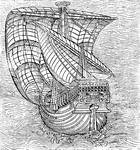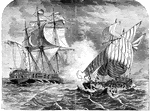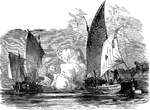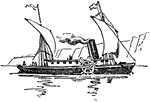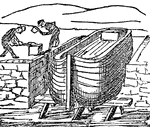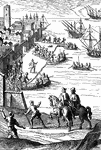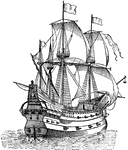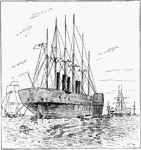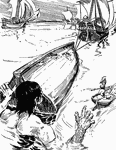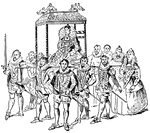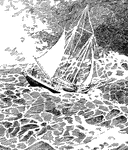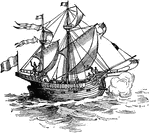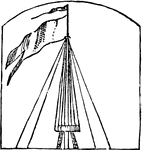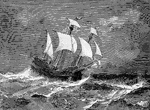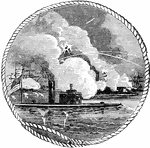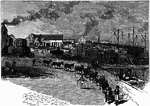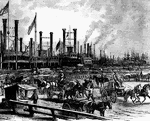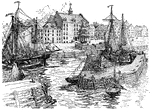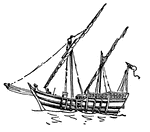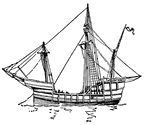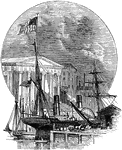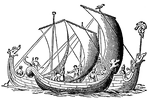
Anglo-Saxon Ships with Wind in the Sails
A fleet of three ancient Anglo-Saxon ships, each with wind filling the lone sail. Each ship has a dragon…

Armada
An illustration of the Spanish Armada. In etymological origin, armada is a Spanish word meaning "armed"…

Spanish Armada
An illustration of the Spanish Armanda. The Spanish Armada was the Spanish fleet that sailed against…
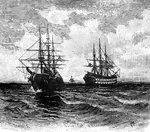
Atlantic Cable
"Laying the Atlantic Cable. In 1866, a previous attempt in 1858 having failed, a telegraphic cable was…
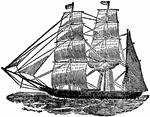
Bark
Or Barque, a three-masted vessel of which the foremast and mainmast are square-rigged, but the mizzenmast…
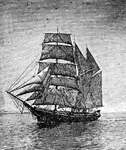
Barkantine
A three masted vessel, with the foremast square rigged, and the mainmast and mizzemast fore and aft…

Japanese Imperial Navy Tatsuta Battlecruiser
Japanese Imperial Navy Tatsuta battlecruiser launched in 1918. One of the first ships to be armed with…

United States Navy Omaha Class Battlecruiser
A U.S. Navy Omaha class battlecruiser launched in 1920. The top speed of the cruiser is 35 knots (40…

British Royal Navy Destroyers and Flotilla Leaders Battleship
"These vessels (destroyers and Flotilla leaders) gradually increased in size and power, and war requirements…

Iron Duke Class British Battleship
A 1912 British navy battleship Iron Duke class. Battleships in this class is operated by steam and have…

Escape of Benedict Arnold
Benedict Arnold escaping capture by George Washington's forces on the Hudson River.
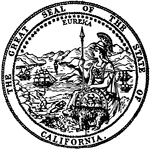
Seal of California
The Great Seal of the State of California. The seal shows Eureka with a bear cub. In the background…

Burning of Confederate gunboats
"Burning of the Confederate gunboats, rams, etc., at New Orleans and Algiers, on the approach of the…

The Consititution Capturing the Cyane and Levant
The Constitution engaging two British ships, the Cyane and Levant.

Naval Crown
"The naval crown is a golden circle surmounted with sterns and square sails of ships, placed alternately."—Aveling,…
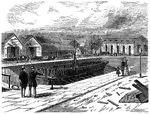
Dry Dock
An illustration of a dry dock, a narrow basin or vessel that can be flooded to allow a load to be floated…
Federal Fleet
"Panoramic view of the Federal fleet passing the forts of the Mississippi, on its way to New Orleans,…
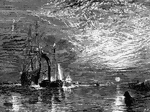
Fighting Temeraire
This painting by J. William Turner is a prime example of the style and technique that he often used.…
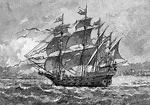
Great Harry
"The Great Harry, the First Famous Ship of the English Navy, built in 1512."—Scudder, 1897
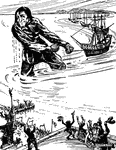
Gulliver in Victory
Gulliver takes the enemy's fleet, the Blefuscudians, and victoriously drags them into the royal port…
Gunboat engagement
"Engagement between the United States gunboats, commanded by Commodore Davis, and the Confederate Mosquito…

Fort Hatteras
View of the camp of the twentieth Indiana Regiment; also of Fort Hatteras and the anchorage at Hatteras…

Kearsarge Sinking the Alabama
The sinking of the Alabama by the Union Kearsarge. Some Confederates aboard the Alabama escaped to England…

Nantes
The romantisit, J. William Turner, was famous for his drawings of landscapes. In this painting he drew…

The Great Naval Battle of the Mississippi
Passage of the second division of the Federal Squadron past Fort St. Philip. On April 24, 1862 at three…

The Great Naval Battle on the Mississippi
First day's bombardment, Federal Schooners off Forts Jackson and St. Philip, commanding the passage…
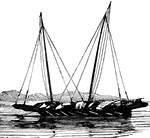
Pindjajap
A boat of Sumatra and the Malay archipelago, with from one to three masts, generally two, carrying square…

Port Eads
Port Eads, Louisiana, is located at the southern tip of the Mississippi River, also known as South Pass…
